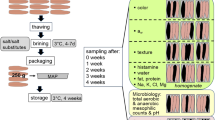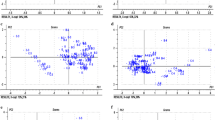Abstract
A taste-enhancement process for cold-stored, raw shell-stock Crassostrea virginica oysters (i.e., application of table salt to shells) when externally contaminated with human enteropathogens intensified spillage of these enteropathogens to oyster’ storage containers (77% compared to 27% for controls) but did not, however, cause contamination of edible oyster tissue.
Similar content being viewed by others
References
Andrews LS, Park DL, Chen YP (2000) Low temperature pasteurization to reduce the risk of Vibrio infections from raw shell-stock oysters. Food Addit Contam 17:787–791
Ash LR, Orihel TC (1987) Parasites: a guide to laboratory procedures and identification. ASCP Press, Chicago, IL, USA
Calvo M, Carazo M, Arias ML, Chaves C, Monge R, Chinchilla M (2004) Prevalence of Cyclospora sp., Cryptosporidium sp., microsporidia and fecal coliform determination in fresh fruit and vegetables consumed in Costa Rica. Arch Latinoam Nutr 54:428–432
Cook D, Oleary WP, Hunsucker JC, Sloan EM, Bowers JC, Blodgett RJ et al (2002) Vibrio vulnificus and Vibrio parahaemolyticus in U.S. retail shell oysters: a national survey from June 1998 to 1999. J Food Prot 65:79–87
Coupe S, Delabre K, Pouillot R, Houdart S, Santillana-Hayat M, Derouin F (2006) Detection of Cryptosporidium, Giardia, and Enterocytozoon bieneusi in surface water, including recreational areas; a one-year prospective study. FEMS Immunol Med Microbiol 47:351–359
Dowd SE, Gerba CP, Pepper IL (1998) Confirmation of the human pathogenic microsporidia Enterocytozoon bieneusi, Encephalitozoon intestinalis, and Vittaforma corneae in water. Appl Environ Microbiol 64:3332–3335
Fournier S, Liguory O, Santillana-Hayat M, Guillot E, Sarfari C, Dumoutier N et al (2000) Detection of microsporidia in surface water: a one-year follow-up study. FEMS Immunol Med Microbiol 29:95–100
Franzen C, Muller A (1999) Cryptosporidia and microsporidia: waterborne diseases in the immunocompromised host. Diagn Microbiol Infect Dis 34:245–262
Gooch JA, Depaola A, Bowers J, Marshall DL (2002) Growth and survival of Vibrio parahaemolyticus in postharvest American oysters. J Food Prot 65:970–974
Graczyk TK (2003) Human waterborne parasites in molluscan shellfish. J Parasitol 89:557–561
Graczyk TK, Schwab KJ (2000) Food borne infections vectored by molluscan shellfish. Curr Gastroenterol Rep 2:305–309
Graczyk TK, Cranfield MR, Fayer R (1997) Recovery of waterborne oocysts of Cryptosporidium parvum from water samples by the membrane-filter dissolution method. Parasitol Res 83:121–125
Graczyk TK, Girouard AS, Tamang L, Nappier SP, Schwab KJ (2006) Recovery, bioaccumulation, and inactivation of human waterborne pathogens by the Chesapeake Bay non-native oyster, Crassostrea ariakensis. Appl Environ Microbiol 72:3390–3395
Graczyk TK, Lucy FE, Tamang L, Miraflor A (2007a) Human enteropathogen load in activated sewage sludge and corresponding sewage sludge-end products. Appl Environ Microbiol 73:2013–2015
Graczyk TK, Johansson M, Tamang L, Visvesvara GS, Moura LS, DaSilva AJ et al (2007b) Retrospective species identification of microsporidian spores in diarrhetic fecal samples from HIV/AIDS patients by multiplexed fluorescent in situ hybridization (FISH). J Clin Microbiol 45:1255–1260
Graczyk TK, McOliver C, Silbergeld EK, Tamang L, Roberts JD (2007c) Risk of handling as a route of exposure to infectious waterborne Cryptosporidium parvum oocysts by Atlantic blue crabs (Callinectes sapidus). Appl Environ Microbiol 73 (in press)
Jedrzejewski S, Graczyk TK, Slodkowicz-Kowalska A, Tamang L, Majewska AC (2007) A quantitative assessment of the contamination of fresh food produce from various retail types with human-virulent microsporidian spores. Appl Environ Microbiol 73 (in press)
Lorca TA, Pierson MD, Flick GJ, Hackney CR. (2001) Levels of Vibrio vulnificus and organoleptic quality of raw shell-stock oysters (Crassostrea virginica) maintained at different storage temperatures. J Food Prot 64:1716–1721
Slodkowicz-Kowalska A, Graczyk TK, Tamang L, Jedrzejewski S, Nowosad A, Zduniak P et al (2006) Microsporidia species known to infect humans are present in aquatic birds; implications for transmission via water? Appl Environ Microbiol 72:4540–4544
Sparfel JM, Sarfati C, Liquory O, Caroff B, Dumoutier N, Gueglio B et al (1997) Detection of microsporidia and identification of Enterocytozoon bieneusi in surface water by filtration followed by specific PCR. J Eukaryot Microbiol 44:78
Thurston-Enriquez JA, Watt P, Dowd SE, Enriquez R, Pepper IL, Gerba CP (2002) Detection of protozoan parasites and microsporidia in irrigation waters used for crop production. J Food Prot 65:378–382
Weber R, Bryan RT (1994) Microsporidial infections in immunodeficient and immunocompetent patients. Clin Infect Dis 19:517–521
Acknowledgments
The study was supported by the Fulbright Senior Specialist Fellowship (grant no. 2225 to Graczyk), Johns Hopkins NIEHS Center in Urban Environmental Health (grant no. P30 ES03819), Johns Hopkins Faculty Research Innovation Fund, Johns Hopkins Center for a Livable Future, and the University of the District of Columbia (grant no. GF4136F4201).
Author information
Authors and Affiliations
Corresponding author
Rights and permissions
About this article
Cite this article
Graczyk, T.K., Tamang, L. & Pelz, R. The effect of a taste-enhancement process for cold-stored raw shell-stock oysters (Crassostrea virginica) on the spillage of human enteropathogens. Parasitol Res 101, 1483–1486 (2007). https://doi.org/10.1007/s00436-007-0664-y
Received:
Revised:
Accepted:
Published:
Issue Date:
DOI: https://doi.org/10.1007/s00436-007-0664-y




